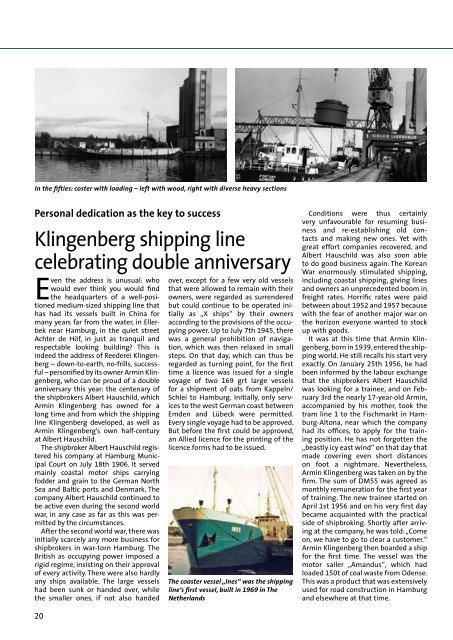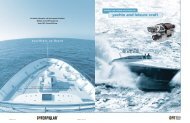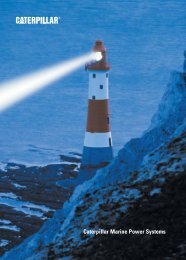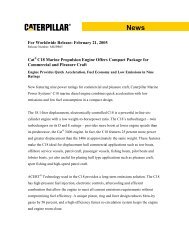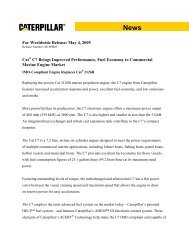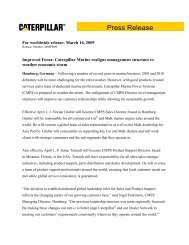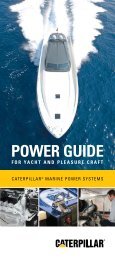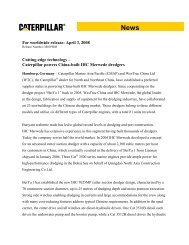Caterpillar Marine - Marine Engines Caterpillar
Caterpillar Marine - Marine Engines Caterpillar
Caterpillar Marine - Marine Engines Caterpillar
You also want an ePaper? Increase the reach of your titles
YUMPU automatically turns print PDFs into web optimized ePapers that Google loves.
In the fifties: coster with loading – left with wood, right with diverse heavy sections<br />
Personal dedication as the key to success<br />
Klingenberg shipping line<br />
celebrating double anniversary<br />
Even the address is unusual: who<br />
would ever think you would find<br />
the headquarters of a well-positioned<br />
medium-sized shipping line that<br />
has had its vessels built in China for<br />
many years far from the water, in Ellerbek<br />
near Hamburg, in the quiet street<br />
Achter de Höf, in just as tranquil and<br />
respectable looking building? This is<br />
indeed the address of Reederei Klingenberg<br />
– down-to-earth, no-frills, successful<br />
– personified by its owner Armin Klingenberg,<br />
who can be proud of a double<br />
anniversary this year: the centenary of<br />
the shipbrokers Albert Hauschild, which<br />
Armin Klingenberg has owned for a<br />
long time and from which the shipping<br />
line Klingenberg developed, as well as<br />
Armin Klingenberg’s own half-century<br />
at Albert Hauschild.<br />
The shipbroker Albert Hauschild registered<br />
his company at Hamburg Municipal<br />
Court on July 18th 1906. It served<br />
mainly coastal motor ships carrying<br />
fodder and grain to the German North<br />
Sea and Baltic ports and Denmark. The<br />
company Albert Hauschild continued to<br />
be active even during the second world<br />
war, in any case as far as this was permitted<br />
by the circumstances.<br />
After the second world war, there was<br />
initially scarcely any more business for<br />
shipbrokers in war-torn Hamburg. The<br />
British as occupying power imposed a<br />
rigid regime, insisting on their approval<br />
of every activity. There were also hardly<br />
any ships available. The large vessels<br />
had been sunk or handed over, while<br />
the smaller ones, if not also handed<br />
20<br />
over, except for a few very old vessels<br />
that were allowed to remain with their<br />
owners, were regarded as surrendered<br />
but could continue to be operated initially<br />
as „X ships“ by their owners<br />
according to the provisions of the occupying<br />
power. Up to July 7th 1945, there<br />
was a general prohibition of navigation,<br />
which was then relaxed in small<br />
steps. On that day, which can thus be<br />
regarded as turning point, for the first<br />
time a licence was issued for a single<br />
voyage of two 169 grt large vessels<br />
for a shipment of oats from Kappeln/<br />
Schlei to Hamburg. Initially, only services<br />
to the west German coast between<br />
Emden and Lübeck were permitted.<br />
Every single voyage had to be approved.<br />
But before the first could be approved,<br />
an Allied licence for the printing of the<br />
licence forms had to be issued.<br />
The coaster vessel „Ines“ was the shipping<br />
line‘s first vessel, built in 1969 in The<br />
Netherlands<br />
Conditions were thus certainly<br />
very unfavourable for resuming business<br />
and re-establishing old contacts<br />
and making new ones. Yet with<br />
great effort companies recovered, and<br />
Albert Hauschild was also soon able<br />
to do good business again. The Korean<br />
War enormously stimulated shipping,<br />
including coastal shipping, giving lines<br />
and owners an unprecedented boom in<br />
freight rates. Horrific rates were paid<br />
between about 1952 and 1957 because<br />
with the fear of another major war on<br />
the horizon everyone wanted to stock<br />
up with goods.<br />
It was at this time that Armin Klingenberg,<br />
born in 1939, entered the shipping<br />
world. He still recalls his start very<br />
exactly. On January 25th 1956, he had<br />
been informed by the labour exchange<br />
that the shipbrokers Albert Hauschild<br />
was looking for a trainee, and on February<br />
3rd the nearly 17-year-old Armin,<br />
accompanied by his mother, took the<br />
tram line 1 to the Fischmarkt in Hamburg-Altona,<br />
near which the company<br />
had its offices, to apply for the training<br />
position. He has not forgotten the<br />
„beastly icy east wind“ on that day that<br />
made covering even short distances<br />
on foot a nightmare. Nevertheless,<br />
Armin Klingenberg was taken on by the<br />
firm. The sum of DM55 was agreed as<br />
monthly remuneration for the first year<br />
of training. The new trainee started on<br />
April 1st 1956 and on his very first day<br />
became acquainted with the practical<br />
side of shipbroking. Shortly after arriving<br />
at the company, he was told: „Come<br />
on, we have to go to clear a customer.“<br />
Armin Klingenberg then boarded a ship<br />
for the first time. The vessel was the<br />
motor sailer „Amandus“, which had<br />
loaded 150t of coal waste from Odense.<br />
This was a product that was extensively<br />
used for road construction in Hamburg<br />
and elsewhere at that time.


